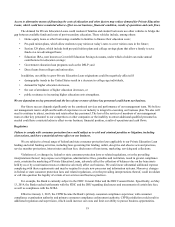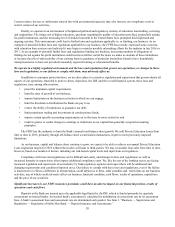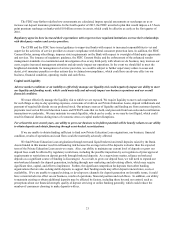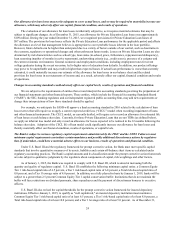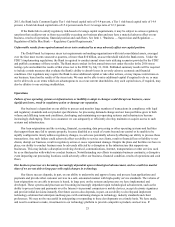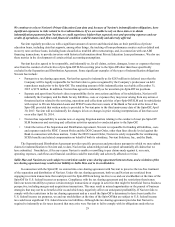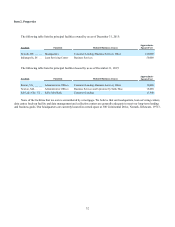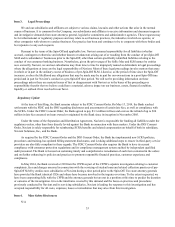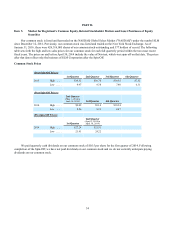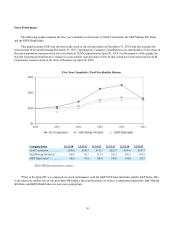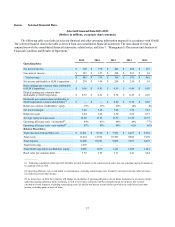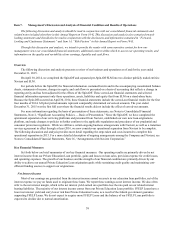Sallie Mae 2015 Annual Report Download - page 30
Download and view the complete annual report
Please find page 30 of the 2015 Sallie Mae annual report below. You can navigate through the pages in the report by either clicking on the pages listed below, or by using the keyword search tool below to find specific information within the annual report.28
assumptions or estimates, we may under- or overstate reported financial results, which could materially and adversely affect our
business, financial condition and results of operations.
Our framework for managing risks may not be effective in mitigating our risk of loss.
Our risk management framework seeks to mitigate risk and appropriately balance risk and return. We have established
processes and procedures intended to identify, measure, monitor, control and report the types of risk to which we are subject.
We seek to monitor and control our risk exposure through a framework of policies, procedures, limits and reporting
requirements. Management of risks in some cases depends upon the use of analytical and/or forecasting models. If the models
that we use to mitigate these risks are inadequate, we may incur increased losses. In addition, there may be existing or
developing risks that we have not appropriately anticipated, identified or mitigated. If our risk management framework does not
effectively identify or mitigate our risks, we could suffer unexpected losses and our financial condition and results of operations
could be materially adversely affected.
Our internal controls over financial reporting and disclosure controls may be ineffective.
Our management is responsible for maintaining, regularly assessing and, as necessary, making changes to our internal
controls over financial reporting and our disclosure controls. Nevertheless, our internal controls over financial reporting and our
disclosure controls can provide only reasonable assurances regarding the reliability of our financial reporting and the
preparation of our financial statements for external purposes in accordance with generally accepted accounting principles in the
United States ("GAAP") and may not prevent or detect misstatements. Any failure or circumvention of our internal controls
over financial reporting or our disclosure controls, failure to comply with rules and regulations related to such controls or
failure to make sound and appropriate application of the criteria established in the framework set forth in Internal Control-
Integrated Framework (2013) issued by the Committee of Sponsoring Organizations of the Treadway Commission could have a
material adverse effect on our financial condition and results of operations.
We are subject to reputational and other risks related to customer or employee fraud.
Employee and customer misconduct could subject us to financial losses, lawsuits or regulatory sanctions and severely
harm our reputation. Misconduct by our customers could include such activities as providing fraudulent credentials, information
or authorization on behalf of a family member or other cosigner through identification theft or by other means in order to secure
loan approval. Customers also may attempt to fraudulently secure Private Education Loan proceeds. Misconduct by our
employees could include, among other things, theft of our or our customers’ confidential information, or making unauthorized
payments on behalf of a collection client in order to meet certain incentive thresholds.
If our internal controls fail to prevent or detect an occurrence of customer or employee fraud, or if any resulting loss is not
insured, exceeds applicable insurance limits or insurance is denied, such occurrence could have a material adverse effect on our
reputation, financial condition and results of operations.
Risks Related to the Spin-Off
We may incur significant additional costs in connection with operating as a stand-alone company.
We may incur significant additional costs in connection with our operation as a stand-alone public company and the full
implementation of the Spin-Off. For example, Navient and its affiliates continue to provide certain services to us and our
affiliates under various transition agreements for specified transition periods and potentially thereafter. The fees charged by
Navient and its affiliates for the provision of these services to us and our affiliates may be higher than the costs that were
allocated to these services prior to the Spin-Off. In addition, prior to the Spin-Off our businesses obtained services from, or
engaged in transactions with, our affiliates under intercompany agreements. All of these factors will result in costs that are
higher than the amounts reflected in historical financial statements, which could cause our profitability to decrease.



